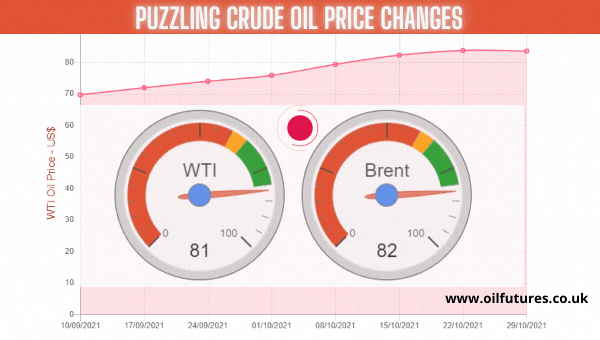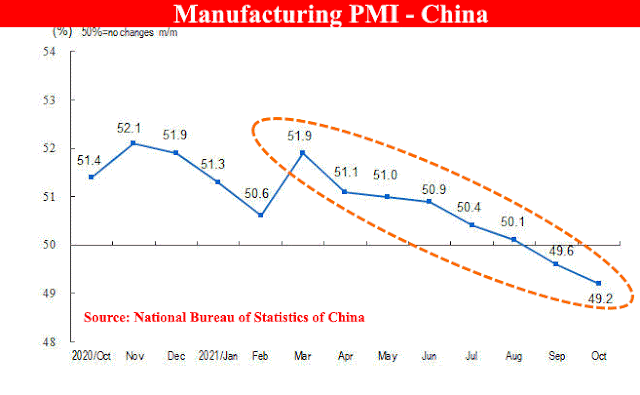The price of crude oil recorded a relatively sharp fall on Wednesday, defying the ‘prophesies’ of certain investment banks. As of 16:00 GMT, the price of WTI and Brent stood at $80.82 and $82.04 respectively, a fall of more than 3%.
The key reasons behind the fall of oil price may be
the following:
- China’s weak economic data for eight successive months
- The fall of US crude inventories for six successive weeks
- The tremendous pressure brought upon the OPEC+ members to increase the oil output
- The flare-ups of the Delta variant – or sub variant – of the Covid-19 in many parts of the world
As for China’s economy, the authorities did not hide
the fact that its economy continues to slow down, hit by supply chain issues,
rising energy costs, power shortages and rising unemployment numbers.
China’s manufacturing PMI index fell by 0.4%, from
49.6% in September to 49.2% in October, according to the National Statistics
Bureau of Statistics of China; it has been in decline for months in the
aftermath of the pandemic, having recorded an impressive growth for years.
China, however, did not attribute the disappointing
performance of the world’s second largest economy to the evolving political
fallouts with its neighbours - and the West; its deteriorating relations with
one of its immediate neighbours, India, for instance, is a case in point; since
the latter is an important market, India can make a reasonable impact on the
Chinese economy, although that may not be a hammer-blow.
The poor performance of one of China’s star
companies, Huawei, for instance, is also due to the political manoeuvres,
rather than economic reasons.
If China’s manufacturing sector continues to shrink,
its impact on the crude oil markets will be huge, because China is the world’s
top importer of the crude oil.
China is not the only country that is causing ripples
in the crude oil markets, though. In the US, the crude inventories have been
falling for six successive weeks, despite the vehicles being on roads and
aeroplanes in the skies.
The latest data from the API, American Petroleum
Institute, shows an inventory build-up of 3.59 million barrels, when the
estimate was 1.567 million barrels.
Analysts believe the build-up of the crude inventories
is partly due to the rising fuel prices.
The OPEC+ ministerial meeting, meanwhile, is going
to take place on November 4, amidst the uncertainty surrounding the crude oil
markets.
The individual members, especially from the Middle
East, are under tremendous pressure to increase the production in order to rein
in the prices. The OPEC+ has been resisting the move by justifying the status
quo, on the ground of generating money for more investments.
It, however, may not be possible for the key members
of the OPEC+to ignore the US pleas for ever, especially when the last of those
is made by the world’s most powerful man on the planet, the US president; they
will not be to do that at the expense of the security of the individual countries.
In this context, the ministerial meeting of the
OPEC+, scheduled for tomorrow, is going to be an interesting one and analysts
are closely watching the developments.
The fall in price of crude oil, perhaps, stems from
the growing anxiety over the unsustainable price of the commodity as well, especially
when the battered world tries to recover from the pandemic.
In addition, the outbreaks of the Delta variant of
the Coronavirus show no sign of a let-up: in China, it has flared up in certain
regions and in a few regions the officials urged people to stock up on food and
essential items, something they downplayed a day later.
All in all, the ministerial meeting of the tomorrow’s
OPEC+ meeting is going to be one of the most important gatherings of the cartel
this year, in determining the price of
crude oil and the path that the members have to tread on, fulfilling its
responsibility in the global energy sector.








